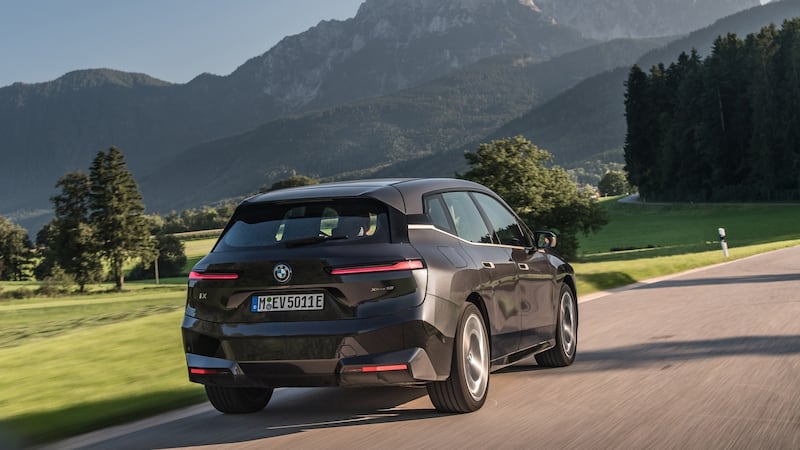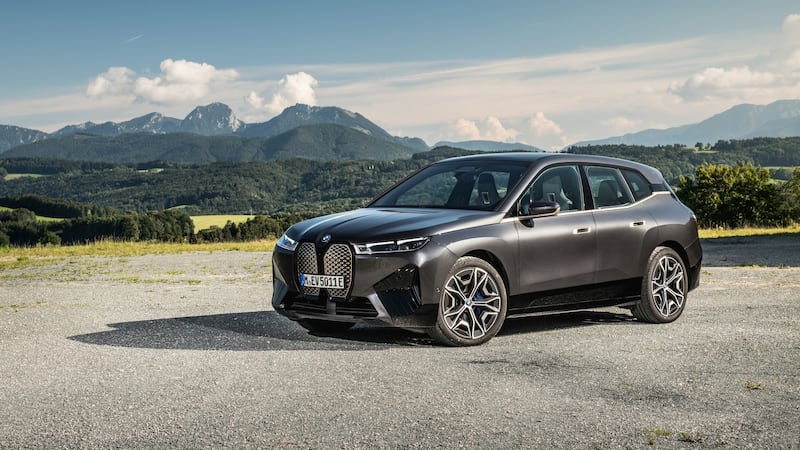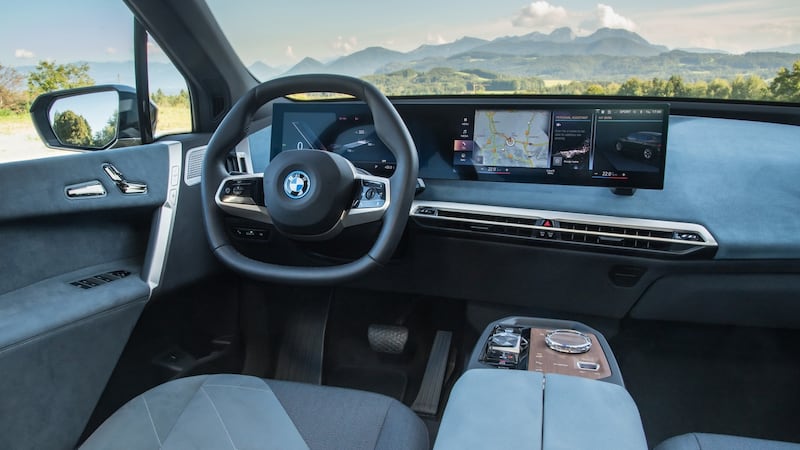This is the face of BMW’s future – and on first impressions it’s one that only a mother would love.
But when it comes to this Bavarian brand, time has a tendency to prove them right. Think back to the days of Chris Bangle, the man who put the "bling" in BMW back in the noughties. From the "Bangle butt" on the new BMWs of that era to the controversial move to the rotary dial iDrive control, the US designer drew a lot of heat.
Several anti-Bangle websites sprang up at the time. One described him as a "diabolical super robot sent from the future by Mercedes-Benz to destroy BMW". An online "Stop Chris Bangle" petition collected over 10,000 signatures.
Within a few years, the BMW styling looked spot on, with the iDrive format adopted by every major rival.
So it's a bit foolhardy to dismiss the iX's styling, in particular that grille. Speaking to The Irish Times in November, BMW i Design boss Kai Langer, who led the iX design, said the controversial grille is a signature feature of the new look for its cars, but also the home for a host of new tech: camera technology, radar functions and other sensors are integrated into the grille – which BMW now calls an "intelligence panel".
Inside is just as radical with new tech, if a lot more stylised and smart.
What we have here is not only a five-seater, all-electric crossover capable of 623km on a single charge, but something that represents the latest in design and tech from the Bavarians.
Longer body
The iX is slightly longer than the brand’s X5 SUV, but narrower with lower ground clearance and roofline, akin to an X6.
Roll it onto the road and the first takeaway is the silence. Nearly absolute silence. BMW has clearly spent a lot of time on this – and apparently learned a lot of lessons from sister company Rolls Royce. This car is whisper-quiet. Little touches like the use of Bridgestone tyres filled with acoustic foam to reduce noise certainly help.

BMW is also bringing forward innovations from previous cars, ones that most buyers will never get to see. For example, the company pioneered the use of carbon fibre frames in mass-produced cars when it developed the small i3. Now it’s bringing that tech to a much larger car. As Formula One engineers will attest, that means lightweight but incredible strength.
The interior and its layout impresses more than the exterior. Despite being all-wheel drive there is no transmission tunnel to trip over so access for all occupants is great. The iX dash features a widescreen display comprising two screens: a 12.3-inch display for the driver’s instruments that can be read through the polygonal “kind-of-round” steering wheel and a larger 14.9-inch screen that displays everything else.
BMW is persisting with its less-than-perfect gesture control functionality, but there are some impressive new tech, like the very smart augmented-reality navigation and smart phone integration. Owners can, for example, precondition a host of features on the car before they even get in to drive away.
It is a connected car with an in-built 5G data SIM and buyers will be offered over-the-air updates that take circa 20 minutes to upload and install. Some will be free while others that release access to new driving or usage features will be available on a subscription basis.
Driving modes
The iX powertrain is impressive and extremely responsive. There are selectable driving modes that worked well with our air suspension-equipped iX xDrive50 delivering an economical, sporty, comfortable or adaptive driving style.
As with BMW naming style these days, the bigger the number the more powerful the car. The iX range starts with the 326hp/630nm iX xDrive40 model that has a maximum driving range from a full of 414km. Next is our test car the iX xDrive50 with 523hp/765nm with a maximum range of 623km. The iX xDrive60 range topper pushes out 600hp/1100nm.

The 50 can sprint from 0-100 km/h in 4.6 seconds. BMW’s all-wheel drive xDrive system uses dual motors with one on either axle, delivering excellent traction thanks to new “near-actuator wheel slip limitation technology”.
The iX can be driven with ease, but it is capable of breath-taking performance.
As a rule, all electric cars deliver power quicker than petrol engines but the iX goes further and delivers its power better than most electric cars.
At any speed, a dab on the accelerator will see the iX leap forward with a giggle-inducing kick. Many electric cars cannot deliver high top speeds; after all the open road is the EV’s enemy offering little chance of energy recuperation.
However, that doesn’t seem to be an issue with the iX and, on unrestricted sections of autobahn where there is no limit, we reached our cars top speed of 200km/h with surprising ease.
Stability and cornering felt assured at all speeds and the driving position gave a commanding view of the road ahead. Adaptive cruise control and level-2 autonomous driving functions – which does much of the steering and cornering – were also a great aid when simply cruising was the order of the day. All iX models leave the factory prepared for level-3 automation if and when it’s ready for public roads.
Battery cell technology
Power is provided by BMW’s fifth-generation battery cell technology that packs a lot more punch than its predecessors. Its energy density at cell level is up by circa 40 per cent compared to the high-voltage battery in the 2020 BMW i3, for example.
The iX xDrive50 is fitted with a 111.5 kWh battery, while the BMW iX xDrive40 gets a 76.6 kWh battery.
The battery in the 50 can rapid DC charge from 10 per cent to 80 per cent capacity in 35 minutes at a supercharger station. The 40 does it in 31 minutes.
Wisely BMW has fitted the iX with a heat pump. These are very important for one big reason: range. Basically heat pumps deliver massive energy savings in terms of climate control, thereby delivering the promised battery range in all temperatures, both hot and cold. Too often motorists find their range severely impacted in summer heatwaves and biting winters. Heat pumps sort out these weather-related fluctuations, offering the sort of reassurance motorists want.
In keeping with efforts to reduce its environmental footprint, no rare earth metals feature in the IX's electric motor. And at the production plan in Dingolfing, about 100km northeast of Munich, the cars are built using green, mostly locally sourced hydro-electric power. BMW says it has secured ethically sourced cobalt and lithium from Australia and Morocco while its aluminium is sourced from green energy suppliers that use solar power.

With the iX starting at €85,815, the obvious rivals include the Audi e-tron Sportback (from €85,380) and the impressive Mercedes-Benz EQC400 (€84,155). Move up the variants and at the higher end of the market is Tesla's Model X Long Range model at a nose-bleeding €111,990. Arguably all are better-looking than the iX but in every other sense the BMW – on first impressions from our initial test drives – has the lead on rivals.
Johann Kistler, the iX project leader, is a BMW veteran whose past projects include the X5, X6 and X7. He describes the iX as another "lighthouse car" for BMW. With that grille you can certainly see it coming, but from behind the wheel you truly get the impressions its engineers are trying to shine a light to the future. Anyone with memories of the Bangle era knows it's foolish to dismiss this brand's visions too quickly.


















